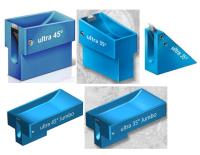 Add My Company
Add My Company
Sign In
Different Diamond Knives & Their Uses
05-02-2020

Different Diamond Knives & Their Uses
Glass knives for cutting ultrathin sections for electron microscopy were first introduced by Latta and Hartman in 1950, replacing the almost impossible process of sharpening metal knives or blades to an edge suitable for ultramicrotomy. In 1953 Dr Humberto Fernandez Moran published his results with the sharpening of gem quality diamond knives (thus free of flaws) for ultramicrotomy and eventually set up a group manufacturing diamond knives in his native Venezuela. Initially specimens sectioned were soft metals but this rapidly expanded into the biological sciences. The manufacturing process was slow and delivery for new knives was at least 12 months although each knife was delivered with a panoramic photo of the entire cutting edge. He also designed an ultramicrotome which was built and marketed by Leitz and could be adapted for cryoultramicrotomy.
Diatome Ultra Knives
These knives are available in 35˚ and 45˚ angles and with Standard or Jumbo water baths. The optimal thickness range for cutting with these knives is between 30-150nm. They are available in sizes ranging from 1.5mm-4.0mm. Other sizes are available upon request. All of these knives are tested within a thickness range of 30-150nm. Historically diamond knives had a 45˚ facet angle but recent work shows that a 35˚ angle gives lower compression with only marginally less durability of the knife edge. Whether fitted into a Standard or Jumbo boat the water surface is horizontal when set at 6˚ clearance angle in the U/M, giving better viewing of and access to the sections. The triangular (dry) holder is used when sections are required for elemental analysis. See the following link:
https://taab.co.uk/pdf-products.php?cat_id=15&sub_cat_id=73&pdf_id=25
The ultra semi is a 35˚ knife that has the ability to cut alternate thick/thin sections from 50/500nm and is available with or without a water bath.
Diatome ultra AFM knives are made of highest quality diamond to ensure the increased quality requirements of AFM investigation. They produce extremely smooth sample surfaces and guarantee the best possible structural preservation.
Diatome Ultra Cryo Knives
for low temperature work
Diatome cryo knives are perfect for sectioning sucrose protected and frozen hydrated samples, as well as industrial samples such as polymers, rubber, etc.
The triangular holder is suitable for dry sectioning and the holder with a trough for sectioning using fluids, (DMSO/water). A cryo-resistant epoxy resin is used to seal the diamond in the holder.
The cryo 35° knife has demonstrated its usefulness as the standard knife for low temperature sectioning of polymers, rubber, paints, etc. and represents a balanced compromise between section quality and durability. The cryo 45° knife is well suited for routine cryo sectioning.
The cryo 25° knife is designed for sectioning frozen hydrated specimens. The 25° angle results in the least possible compression and the best structural preservation.
The cryo immuno, the first knife with a diamond platform, guarantees the best possible sectioning for cryo-immunochemistry. The diamond platform permits easy and gentle section collection. Sections are collected directly from the diamond surface using a loop and a sucrose/methylcellulose droplet. The 35° cutting angle leads to a considerable reduction in mechanical stresses and therefore to improved structural preservation in sucrose-protected samples. For all cryo sectioning of biological as well as industrial specimens, the use of an ionizer is essential.
The cryo AFM brings extra performance to low temperature AFM investigations.
Diatome histo knives
for semi-thin sectioning
Diatome histo knives
The histo knife is designed for semi-thin sections of both hard and soft biological and materials research specimens, unembedded or embedded in acrylic or epoxy resins. Histo knives can be used on all ultramicrotomes as well as on other microtomes with a retraction of the specimen arm on the return stroke.
histo cryo knives are delivered with a boat for wet sectioning using a DMSO/water mixture or mounted in a triangular holder for dry sectioning.
Diatome Trimming Tools
The Diatome Trimming Tools trim 20, trim 45 and trim 90
Areas of Application
Room Temperature:
Epoxy or acrylic resin embedded biological samples
• Metals
• Polymers
• Nanoparticles in polymers
• non-embedded brittle samples
Cryo Temperatures:
• Sucrose infiltrated and frozen hydrated bilogoical samples
• Soft polymers
For successful ultramicrotomy in biology and materials science, precise trimming is mandatory.
The Diatome trimming blades trim 20, trim 45 and trim 90 fulfill all trimming requirements, allowing quick, easy and accurate trimming at both room and cryo-temperatures. Due to the extreme sharpness of the diamond blades, less mechanical damage is applied to the sample during trimming.
Very shiny sample faces and precise sides are the result.
The trim 20 produces pyramidal sides with an inclined angle of 20°, the trim 45 produces pyramidal sides with an inclined angle of 45° and the trim 90 produces square sides.
Caring for Your Diamond Knife
To maximise the useful life of your diamond knife there are some simple handling and cleaning procedures which you can undertake. Please click on the following link for our "Care and Use of Diamond Knives" booklet.
https://taab.co.uk/pdfs.php?cat_id=15&sub_cat_id=73
For more information on Different Diamond Knives & Their Uses talk to TAAB Laboratories Equipment Ltd
Enquire Now
List your company on FindTheNeedle.

